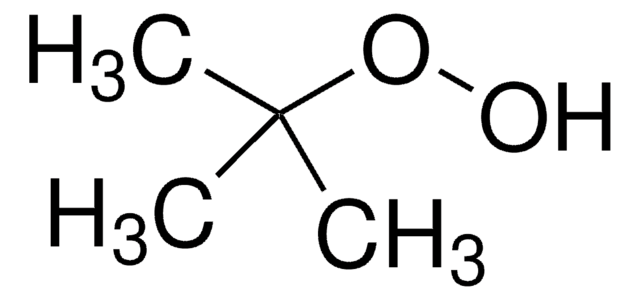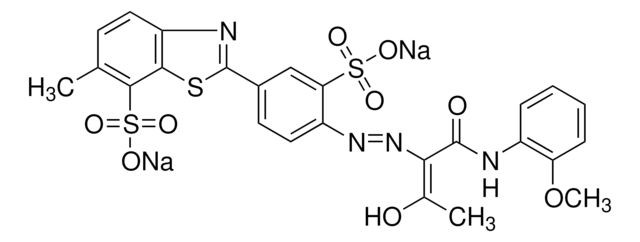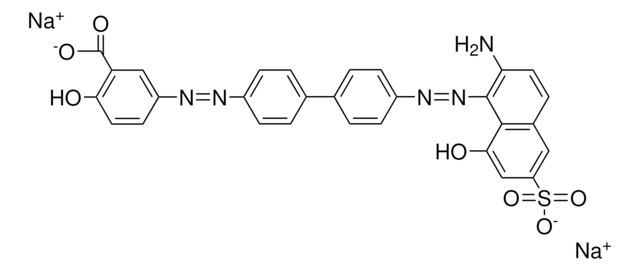910090
Fluorescent Brightener 28 disodium salt solution
used as a stain and brightening agent
Sinônimo(s):
Fluostain I, Calcofluor White LRP, Calcofluor White ST, Calcofluor white M2R, Tinopal LPW
About This Item
Produtos recomendados
forma
liquid
concentração
25% in water
cadeia de caracteres SMILES
[Na+].[Na+].OCCN(CCO)c1nc(Nc2ccccc2)nc(Nc3ccc(\C=C\c4ccc(Nc5nc(Nc6ccccc6)nc(n5)N(CCO)CCO)cc4S([O-])(=O)=O)c(c3)S([O-])(=O)=O)n1
Procurando produtos similares? Visita Guia de comparação de produtos
Descrição geral
Aplicação
- Fluorescent Brightener 28 is used in microscopy as fluorochromes, especially to visualize plant tissues by binding to cellulose.
- It is used in microbiology for staining pathogenic fungi, fungal cell walls, Candida albicans biofilms, for the automated counting of bacteria and spores, and as a viability stain.
- It is a rapid method for the detection of many yeasts and pathogenic fungi such as Microsporidium, Acanthamoeba, Pneumocystis, Naegleria, and Balamuthia species.
- It is used industrially as a fluorescent brightening agent for cellulose and polyamide fabrics, paper, detergents, and soaps.
- It has been used in the identification and study of the structure and biosynthesis of chitin from the freshwater sponge Spongilla lacustris, and to elucidate the location of chitin in skeletal structures.
Ações bioquímicas/fisiológicas
Características e benefícios
- Facilitates rapid detection of many pathogenic yeasts and fungi.
- As a brightening agent, its addition can offset the tendency of white materials to yellow with age.
Código de classe de armazenamento
12 - Non Combustible Liquids
Classe de risco de água (WGK)
WGK 1
Ponto de fulgor (°F)
Not applicable
Ponto de fulgor (°C)
Not applicable
Escolha uma das versões mais recentes:
Certificados de análise (COA)
Não está vendo a versão correta?
Se precisar de uma versão específica, você pode procurar um certificado específico pelo número do lote ou da remessa.
Já possui este produto?
Encontre a documentação dos produtos que você adquiriu recentemente na biblioteca de documentos.
Nossa equipe de cientistas tem experiência em todas as áreas de pesquisa, incluindo Life Sciences, ciência de materiais, síntese química, cromatografia, química analítica e muitas outras.
Entre em contato com a assistência técnica








